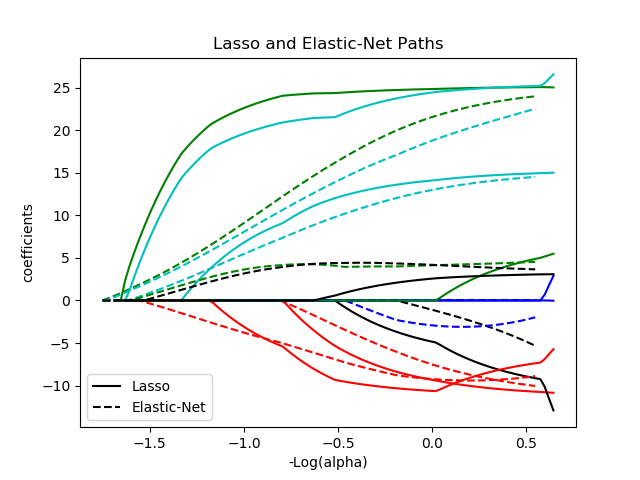sklearn.linear_model.lasso_path?
sklearn.linear_model.lasso_path(X, y, *, eps=0.001, n_alphas=100, alphas=None, precompute='auto', Xy=None, copy_X=True, coef_init=None, verbose=False, return_n_iter=False, positive=False, **params)
[源碼]
計算具有坐標下降的套索路徑
套索優化功能針對單輸出和多輸出而變化。
對于單輸出任務,它是:
對于多輸出任務,它是:
其中:
即每一行的范數之和。
在用戶指南中閱讀更多內容。
| 參數 | 返回值 |
|---|---|
| X | {array-like, sparse matrix} of shape (n_samples, n_features) 用于訓練的數據。直接作為Fortran-contiguous數據傳遞,避免不必要的內存重復。如果 y是單輸出,則X 可以是稀疏的。 |
| y | {array-like, sparse matrix} of shape (n_samples,) or (n_samples, n_outputs) 目標值 |
| eps | float, default=1e-3 路徑的長度。 eps=1e-3意思是 alpha_min / alpha_max = 1e-3 |
| n_alphas | int, default=100 正則化路徑中的Alpha數 |
| alphas | ndarray, default=None 用于在其中計算模型的alpha列表。如果為None,則自動設置Alpha。 |
| precompute | ‘auto’, bool or array-like of shape (n_features, n_features), default=’auto’ 是否使用預先計算的Gram矩陣來加快計算速度。如果設置 'auto'讓我們決定。Gram矩陣也可以作為參數被傳遞。 |
| Xy | array-like of shape (n_features,) or (n_features, n_outputs), default=None 可以預先計算Xy = np.dot(XT,y)。僅當預先計算了Gram矩陣時才有用。 |
| copy_X | bool, default=True 如果為 True,將復制X;否則,它可能會被覆蓋。 |
| coef_init | ndarray of shape (n_features, ), default=None 系數的初始值。 |
| verbose | bool or int, default=False 詳細程度。 |
| return_n_iter | bool, default=False 是否返回迭代次數。 |
| positive | bool, default=False 如果設置為True,則強制系數為正。(僅當 y.ndim == 1時允許)。 |
| **params | kwargs 關鍵字參數傳遞給坐標下降求解器。 |
| 返回值 | 說明 |
|---|---|
| alphas | ndarray of shape (n_alphas,) 沿模型計算路徑的Alpha。 |
| coefs | ndarray of shape (n_features, n_alphas) or (n_outputs, n_features, n_alphas) 沿路徑的系數。 |
| dual_gaps | ndarray of shape (n_alphas,) 每個alpha優化結束時的雙重間隔。 |
| n_iters | list of int 坐標下降優化器為達到每個alpha的指定公差所進行的迭代次數。 |
另見:
注
有關示例,請參閱examples / linear_model / plot_lasso_coordinate_descent_path.py。
為避免不必要的內存重復,fit方法的X參數應作為 Fortran-contiguous的numpy數組直接被傳遞。
請注意,在某些情況下,Lars求解器可能會更快地實現這個功能。特別是,線性插值可用于檢索lars_path輸出值之間的模型系數。
示例
將lasso_path和lars_path與插值進行比較:
>>> X = np.array([[1, 2, 3.1], [2.3, 5.4, 4.3]]).T
>>> y = np.array([1, 2, 3.1])
>>> # Use lasso_path to compute a coefficient path
>>> _, coef_path, _ = lasso_path(X, y, alphas=[5., 1., .5])
>>> print(coef_path)
[[0. 0. 0.46874778]
[0.2159048 0.4425765 0.23689075]]
>>> # Now use lars_path and 1D linear interpolation to compute the
>>> # same path
>>> from sklearn.linear_model import lars_path
>>> alphas, active, coef_path_lars = lars_path(X, y, method='lasso')
>>> from scipy import interpolate
>>> coef_path_continuous = interpolate.interp1d(alphas[::-1],
... coef_path_lars[:, ::-1])
>>> print(coef_path_continuous([5., 1., .5]))
[[0. 0. 0.46915237]
[0.2159048 0.4425765 0.23668876]]

